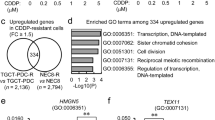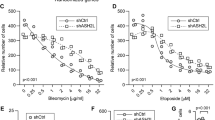Abstract
Testicular germ cell cancers remain one of the few solid tumors routinely cured in advanced stages with conventional cisplatin-based chemotherapy. The mechanisms remain largely unknown. Through use of gene-expression array profiling we define immediate transcriptional targets in response to cisplatin in testicular germ cell-derived human embryonal carcinoma cells. We report 46 genes upregulated and five genes repressed by cisplatin. Several of these gene products, including FAS, TRAILR3, PHLDA3, LRDD, and IER3 are previously implicated in the apoptotic death receptor pathway, while others including SESN1, FDXR, PLK3, and DDIT4 are known mediators of reactive oxygen species generation. Approximately 54% of the upregulated genes are established or suspected downstream targets of p53. Specific siRNA to p53 prevents cisplatin-mediated activation of p53 and p53 pathway genes and renders embryonal carcinoma cells relatively resistant to cisplatin cytotoxicity. Interestingly, in p53 knockdown cells nearly the entire set of identified cisplatin targets fail to respond or have a diminished response to cisplatin, suggesting that many are new direct or indirect targets of p53 including GPR87, STK17A, INPP5D, FLJ11259, and EPS8L2. The data indicate that robust transcriptional activation of p53 is linked to the known hypersensitivity of testicular germ cell tumors to chemotherapy. Many of the gene products may participate in the unique curability of this disease.
This is a preview of subscription content, access via your institution
Access options
Subscribe to this journal
Receive 50 print issues and online access
$259.00 per year
only $5.18 per issue
Buy this article
- Purchase on Springer Link
- Instant access to full article PDF
Prices may be subject to local taxes which are calculated during checkout






Similar content being viewed by others
References
Andrews PW . (1998). APMIS, 106, 158–167.
Bunz F, Hwang PM, Torrance C, Waldman T, Zhang Y, Dillehay L, Williams J, Lengauer C, Kinzler KW and Vogelstein B . (1999). J. Clin. Invest., 104, 263–269.
Burger H, Nooter K, Boersma AW, van Wingerden KE, Looijenga LH, Jochemsen AG and Stoter G . (1999). Int. J. Cancer, 81, 620–628.
Chaganti RS and Houldsworth J . (2000). Cancer Res., 60, 1475–1482.
Chipuk JE, Kuwana T, Bouchier-Hayes L, Droin NM, Newmeyer DD, Schuler M and Green DR . (2004). Science, 303, 1010–1014.
Curtin JC, Dragnev KH, Sekula D, Christie AJ, Dmitrovsky E and Spinella MJ . (2001). Oncogene, 20, 2559–2569.
Debatin KM . (2004). Cancer Immunol. Immunother., 53, 153–159.
Einhorn LH . (2002). Chest Surg. Clin. N. Am., 12, 695–706.
Fei P, Bernhard EJ and El-Deiry WS . (2002). Cancer Res., 62, 7316–7327.
Freemantle SJ, Kerley JS, Olsen SL, Gross RH and Spinella MJ . (2002). Oncogene, 21, 2880–2889.
Jakupec MA, Galanski M and Keppler BK . (2003). Rev. Physiol. Biochem. Pharmacol., 146, 1–53.
Kannan K, Amariglio N, Rechavi G, Jakob-Hirsch J, Kela I, Kaminski N, Getz G, Domany E and Givol D . (2001). Oncogene, 20, 2225–2234.
Kersemaekers AM, Mayer F, Molier M, van Weeren PC, Oosterhuis JW, Bokemeyer C and Looijenga LH . (2002). J. Clin. Oncol., 20, 1551–1561.
Kho PS, Wang Z, Zhuang L, Li Y, Chew JL, Ng HH, Liu ET and Yu Q . (2004). J. Biol. Chem., 279, 21183–21192.
Lutzker SG and Levine AJ . (1996). Nat. Med., 2, 804–810.
Lutzker SG, Mathew R and Taller DR . (2001). Oncogene, 20, 2982–2986.
Martindale JL and Holbrook NJ . (2002). J. Cell Physiol., 192, 1–15.
Masters JR and Koberle B . (2003). Nat. Rev. Cancer, 3, 517–525.
Niedner H, Christen R, Lin X, Kondo A and Howell SB . (2001). Mol. Pharmacol., 60, 1153–1160.
Peng HQ, Hogg D, Malkin D, Bailey D, Gallie BL, Bulbul M, Jewett M, Buchanan J and Goss PE . (1993). Cancer Res., 53, 3574–3578.
Sax JK and El-Deiry WS . (2003). Cell Death Differ., 10, 413–417.
Schrader M, Muller M, Straub B and Miller K . (2001). Reprod. Toxicol., 15, 611–617.
Sperger JM, Chen X, Draper JS, Antosiewicz JE, Chon CH, Jones SB, Brooks JD, Andrews PW, Brown PO and Thomson JA . (2003). Proc. Natl. Acad. Sci. USA, 100, 13350–13355.
Spierings DC, de Vries EG, Vellenga E and de Jong S . (2003a). J. Pathol., 200, 137–148.
Spierings DC, de Vries EG, Vellenga E and de Jong S . (2003b). Cell Death Differ., 10, 808–822.
Spinella MJ, Kerley JS, White KA and Curtin JC . (2003). J. Nutr., 133, 273S–276S.
Thorburn A . (2004). Cell Signal., 16, 139–144.
White KA, Yore MM, Warburton SL, Vaseva AV, Rieder E, Freemantle SJ and Spinella MJ . (2003). J. Biol. Chem., 278, 43889–43892.
Wright MM and McMaster CR . (2002). Biol. Res., 35, 223–229.
Zamble DB, Jacks T and Lippard SJ . (1998). Proc. Natl. Acad. Sci. USA, 95, 6163–6168.
Zamzami N, Marchetti P, Castedo M, Decaudin D, Macho A, Hirsch T, Susin SA, Petit PX, Mignotte B and Kroemer G . (1995). J. Exp. Med., 182, 367–377.
Acknowledgements
We thank Ms Anna Forsman and the Biomedical Array Core at Dartmouth Medical School for performing array hybridizations, Ms Carol Ringelberg for Gene Traffic software assistance, and Dr Julie Vrana for assistance with the mitochondrial potential assay. We thank Dr Sarah Freemantle and Dr Ethan Dmitrovsky for helpful discussion. This work was supported by the American Cancer Society Grant RSG-01-144-01 and the National Institute of Health Grant R01-CA104312.
Author information
Authors and Affiliations
Corresponding author
Rights and permissions
About this article
Cite this article
Kerley-Hamilton, J., Pike, A., Li, N. et al. A p53-dominant transcriptional response to cisplatin in testicular germ cell tumor-derived human embyronal carcinoma. Oncogene 24, 6090–6100 (2005). https://doi.org/10.1038/sj.onc.1208755
Received:
Revised:
Accepted:
Published:
Issue Date:
DOI: https://doi.org/10.1038/sj.onc.1208755
Keywords
This article is cited by
-
Proteomic profiling of cisplatin-resistant and cisplatin-sensitive germ cell tumour cell lines using quantitative mass spectrometry
World Journal of Urology (2022)
-
Naked mole-rat very-high-molecular-mass hyaluronan exhibits superior cytoprotective properties
Nature Communications (2020)
-
PIDD interaction with KEAP1 as a new mutation-independent mechanism to promote NRF2 stabilization and chemoresistance in NSCLC
Scientific Reports (2019)
-
In silico evaluation of DNA Damage Inducible Transcript 4 gene (DDIT4) as prognostic biomarker in several malignancies
Scientific Reports (2017)
-
Involvement of the DNA mismatch repair system in cisplatin sensitivity of testicular germ cell tumours
Cellular Oncology (2017)



